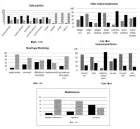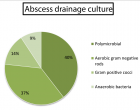Abstract
Research Article
Risk Factors Associated to Patients with Type 2 Diabetes in Lahore District
Snobia Munir*, Samreen Riaz, Tooba Arshad and Aasma Riaz
Published: 21 May, 2020 | Volume 4 - Issue 1 | Pages: 011-019
Our research aimed to check the impact of some significant risk variables on diabetes growth and the specific goal of this study was to evaluate the connection of industrial fields with diabetes risk variables. The current research also informs us about the most important risk factor for male and female people with diabetes. A cross-section and convenient sample of 100 people, male and female, without discernment of risk factors and diabetes mellitus (Meta-Analysis on the effect of major risk factors on the diabetic patients form Jinnah Hospital Lahore). The risk factors in the general assessment i.e. lack of exercise, kidney problems, high ranges of tests and residence in industrial areas are found to be significant. Assessment of these factors is helpful in early diagnosis and in prognosis of diabetes.
Read Full Article HTML DOI: 10.29328/journal.acem.1001014 Cite this Article Read Full Article PDF
Keywords:
Major risk factors; Meta-analysis; Convenient sampling; Associations; Industrial area
References
- World Health Organization. Country Profiles: Pakistan. World Health Organization. 2018.
- Wild S, Roglic G, Green A, Sicree R, King H. Global prevalence of diabetes: estimates for the year 2000 and projections for 2030: response to Rathman and Giani. Diabetes care. 2004; 27: 2568-2569. PubMed: https://pubmed.ncbi.nlm.nih.gov/15451946/
- Shoback DG, Gardner D, eds. Diabetes mellitus. Greenspan's basic & clinical endocrinology Chapter 17. (9th ed.). New York: McGraw-Hill Medical. 2011.
- World Health Organization. Definition, diagnosis and classification of diabetes mellitus and its complications: report of a WHO consultation. Part 1, Diagnosis and classification of diabetes mellitus, Geneva: World health organization. 1999.
- Michalek JE, Pavuk M. Diabetes and cancer in veterans of Operation Ranch Hand after adjustment for calendar period, days of spraying, and time spent in Southeast Asia. J Occup Environ Med. 2008; 50: 330-340. PubMed: https://pubmed.ncbi.nlm.nih.gov/18332783/
- Kang ES, Kim HJ, Nam M, Nam CM, Ahn CW, et al. A novel 111/121 diplotype in the Calpain-10 gene is associated with type 2 diabetes. J Hum Genet. 2006; 51: 629-633. https://pubmed.ncbi.nlm.nih.gov/16721485/
- Yi B, Hu X, Zhang H, Huang J, Liu J, et al. Nuclear NF-κB p65 in peripheral blood mononuclear cells correlates with urinary MCP-1, RANTES and the severity of type 2 diabetic nephropathy. PLoS One. 2014; 9: e99633. PubMed: https://pubmed.ncbi.nlm.nih.gov/24936866/
- Kuo CC, Moon K, Thayer KA, Navas-Acien A. Environmental chemicals and type 2 diabetes: an updated systematic review of the epidemiologic evidence. Curr Diab Rep. 2013; 13: 831-849. PubMed: https://pubmed.ncbi.nlm.nih.gov/24114039/
- Fernández JS. Iron Excess and Risk of Type 2 Diabetes Mellitus in a Prospective Cohort of Mediterranean Population. Cambridge Core. 2016; 112:
- Kanan S, Samara S. Dioxins and furans: A review from chemical and environmental perspectives. Trends in Environmental Analytical Chemistry. 2018; 17: 1-13.
- Kitabchi AE, Umpierrez GE, Miles JM, Fisher JN. Hyperglycemic crises in adult patients with diabetes. Diabetes Care. 2009; 32: 1335–1343. PubMed: https://www.ncbi.nlm.nih.gov/pmc/articles/PMC2699725/
- Pourfarzam M, Zadhoush F, Sadeghi M. The difference in correlation between insulin resistance index and chronic inflammation in type 2 diabetes with and without metabolic syndrome. Adv Biomed Res. 2016; 5: 153. PubMed: https://www.ncbi.nlm.nih.gov/pmc/articles/PMC5046740/
Figures:

Figure 1
Similar Articles
-
Risk Factors Associated to Patients with Type 2 Diabetes in Lahore DistrictSnobia Munir*,Samreen Riaz,Tooba Arshad,Aasma Riaz. Risk Factors Associated to Patients with Type 2 Diabetes in Lahore District. . 2020 doi: 10.29328/journal.acem.1001014; 4: 011-019
Recently Viewed
-
A Low-cost High-throughput Targeted Sequencing for the Accurate Detection of Respiratory Tract PathogenChangyan Ju, Chengbosen Zhou, Zhezhi Deng, Jingwei Gao, Weizhao Jiang, Hanbing Zeng, Haiwei Huang, Yongxiang Duan, David X Deng*. A Low-cost High-throughput Targeted Sequencing for the Accurate Detection of Respiratory Tract Pathogen. Int J Clin Virol. 2024: doi: 10.29328/journal.ijcv.1001056; 8: 001-007
-
A Comparative Study of Metoprolol and Amlodipine on Mortality, Disability and Complication in Acute StrokeJayantee Kalita*,Dhiraj Kumar,Nagendra B Gutti,Sandeep K Gupta,Anadi Mishra,Vivek Singh. A Comparative Study of Metoprolol and Amlodipine on Mortality, Disability and Complication in Acute Stroke. J Neurosci Neurol Disord. 2025: doi: 10.29328/journal.jnnd.1001108; 9: 039-045
-
Development of qualitative GC MS method for simultaneous identification of PM-CCM a modified illicit drugs preparation and its modern-day application in drug-facilitated crimesBhagat Singh*,Satish R Nailkar,Chetansen A Bhadkambekar,Suneel Prajapati,Sukhminder Kaur. Development of qualitative GC MS method for simultaneous identification of PM-CCM a modified illicit drugs preparation and its modern-day application in drug-facilitated crimes. J Forensic Sci Res. 2023: doi: 10.29328/journal.jfsr.1001043; 7: 004-010
-
A Gateway to Metal Resistance: Bacterial Response to Heavy Metal Toxicity in the Biological EnvironmentLoai Aljerf*,Nuha AlMasri. A Gateway to Metal Resistance: Bacterial Response to Heavy Metal Toxicity in the Biological Environment. Ann Adv Chem. 2018: doi: 10.29328/journal.aac.1001012; 2: 032-044
-
Obesity in Patients with Chronic Obstructive Pulmonary Disease as a Separate Clinical PhenotypeDaria A Prokonich*, Tatiana V Saprina, Ekaterina B Bukreeva. Obesity in Patients with Chronic Obstructive Pulmonary Disease as a Separate Clinical Phenotype. J Pulmonol Respir Res. 2024: doi: 10.29328/journal.jprr.1001060; 8: 053-055
Most Viewed
-
Evaluation of Biostimulants Based on Recovered Protein Hydrolysates from Animal By-products as Plant Growth EnhancersH Pérez-Aguilar*, M Lacruz-Asaro, F Arán-Ais. Evaluation of Biostimulants Based on Recovered Protein Hydrolysates from Animal By-products as Plant Growth Enhancers. J Plant Sci Phytopathol. 2023 doi: 10.29328/journal.jpsp.1001104; 7: 042-047
-
Sinonasal Myxoma Extending into the Orbit in a 4-Year Old: A Case PresentationJulian A Purrinos*, Ramzi Younis. Sinonasal Myxoma Extending into the Orbit in a 4-Year Old: A Case Presentation. Arch Case Rep. 2024 doi: 10.29328/journal.acr.1001099; 8: 075-077
-
Feasibility study of magnetic sensing for detecting single-neuron action potentialsDenis Tonini,Kai Wu,Renata Saha,Jian-Ping Wang*. Feasibility study of magnetic sensing for detecting single-neuron action potentials. Ann Biomed Sci Eng. 2022 doi: 10.29328/journal.abse.1001018; 6: 019-029
-
Pediatric Dysgerminoma: Unveiling a Rare Ovarian TumorFaten Limaiem*, Khalil Saffar, Ahmed Halouani. Pediatric Dysgerminoma: Unveiling a Rare Ovarian Tumor. Arch Case Rep. 2024 doi: 10.29328/journal.acr.1001087; 8: 010-013
-
Physical activity can change the physiological and psychological circumstances during COVID-19 pandemic: A narrative reviewKhashayar Maroufi*. Physical activity can change the physiological and psychological circumstances during COVID-19 pandemic: A narrative review. J Sports Med Ther. 2021 doi: 10.29328/journal.jsmt.1001051; 6: 001-007

HSPI: We're glad you're here. Please click "create a new Query" if you are a new visitor to our website and need further information from us.
If you are already a member of our network and need to keep track of any developments regarding a question you have already submitted, click "take me to my Query."

















































































































































